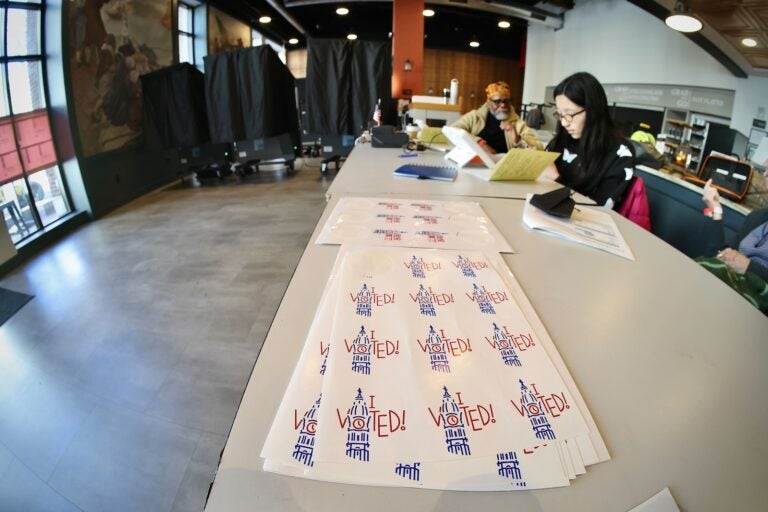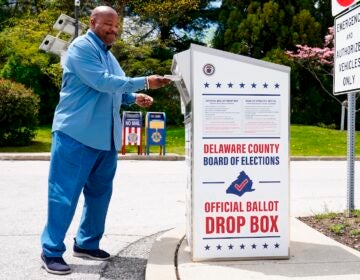How the electorate has changed in key states and what it could mean this election
Significant U.S. population changes in the last two decades have already made an impact on politics. Here's how it's playing out in the seven most closely watched states.

Voting was slow at a polling place at the Museum of the American Revolution, where about 30 people had voted by 10 am. An additional 80 had come to drop off their mail ballots. (Emma Lee/WHYY)
There have been significant population shifts in the last two decades in this country, and that has had a big impact on U.S. politics.
These demographic shifts are, in large measure, the reason why some states, like Ohio and Iowa, are no longer swing states — and why some have come on the map, like Georgia and Arizona.
These demographic shifts have also coincided with shifts within the parties. Republicans have been able to win over larger percentages of whites without college degrees, while Democrats have gained with college-educated white voters and Asian Americans, while also largely maintaining advantages with Black voters and Latinos.
Still, issues matter. The fundamentals on various issues favor Republicans, from views of the economy to immigration, which is why demographics are not necessarily destiny. But they are a crucial part of explaining the political shifts, where the campaigns are focused, and why the seven states everyone is watching most closely are, in fact, the current crop of swing states.
NPR utilized data and projections from William Frey, a demographer at the Brookings Institution, as well as presidential exit polls conducted by Edison Research to do a deeper dive into the data and see what it could mean for this year’s presidential election.
Here are eight important findings:
1. White voters without college degrees have declined as a share of the electorate everywhere pretty significantly since 2008, while Latinos, AAPI voters and whites with degrees have increased dramatically
Whites without degrees were a majority of voters overall in 2008, but are now projected to be less than 40% in 2024.
They are down dramatically in all three Blue Wall states as well since 2008: 12 points in Pennsylvania, 8 in Michigan and 7 in Wisconsin. This is happening without much change to nonwhite groups in the Blue Wall states.
Among the seven swing states, the increase in Latinos has been especially acute in Arizona and Nevada, where they now represent 3-in-10 eligible voters in Arizona and 1 in 5 in Nevada. At the same time, white non-college voters are down significantly in the four Sun Belt swing states since 2008: 14 points in Nevada, 13 in Arizona, 13 in North Carolina and 10 in Georgia.
2. White non-college voters, though, continue to be the largest portion of eligible voters in all of the key swing states
In the Blue Wall states, white non-college voters make up a significant share of the eligible voting population — half or more.
Trump turned them out in greater numbers in 2020 than in 2016. But Biden was able to win all three Blue Wall states because he ate into Trump’s margins with the group in Wisconsin and Michigan and kept it even in Pennsylvania, while also turning out nonwhite groups in his favor.
In fact, Biden did better than Hillary Clinton, the 2016 Democratic nominee, with white non-college voters in five of the seven swing states.
3. Democrats have held up in the Blue Wall states because white non-college voters vote differently there than in the South — and the Blue Wall has more college-educated white voters than at any other time
White voters without degrees in the two southern swing states, Georgia and North Carolina, are much more conservative.
On average in the Blue Wall states, Trump won whites without degrees 61%-38% in 2020, according to exit polls. In Georgia and North Carolina, on the other hand, Trump won them by an average of 79%-21%.
That’s a 23-point margin vs. 58 points.
In Arizona and Nevada, whites without degrees voted more like those in the Blue Wall.
Whites with degrees, meanwhile, are on the rise in the Blue Wall states — up 8 points in Pennsylvania, 6 points in Wisconsin and 5 points in Michigan since 2008. In Wisconsin, they’re up 4 points just since 2020.
It wasn’t just the Blue Wall, either. White college-educated voters shifted heavily away from Trump almost everywhere. In Georgia, North Carolina and Arizona, they moved away from Trump by double-digits — by 30 points in Georgia, 19 in North Carolina, 13 in Arizona and 9 in Nevada.
Democrats’ performance with college-educated white voters is one underreported reason the party continues to stay competitive against Trump.
4. The Sun Belt continues to diversify, and that has put it on the map for Democrats
White voters are down double-digits since 2008 as a share of eligible voters in Nevada, Arizona and North Carolina, and 9 in Georgia. It’s a huge change that has put these states in play.
Latinos and AAPI voters are up significantly in these places as well. Latinos are up 10 points in Arizona, 7 in Nevada, have doubled their eligible-voter population in Georgia and quadrupled in North Carolina since 2008.
Of the swing states, AAPI voters could have the largest impact in Nevada, where they are now almost 10% of the eligible voter population. While AAPI voters are smaller portions of the electorate in other swing states, they have doubled as a share of eligible voters in Arizona, North Carolina, Pennsylvania and Wisconsin in that time.
That trend is only going to continue, because, as of right now, a majority of those under 18 are nonwhite. Gen Z is forecast to be the last generation that is majority white.
Notably, these demographic shifts have helped Democrats to statewide victories for the Senate and governorships. Six of the eight Sun Belt swing-state senators now either are Democrats or caucus with them. That’s a big change from 2008, when seven of the eight were Republicans.
(In the Blue Wall, five of the six senators are Democrats, the same margin as 2008.) Overall, five of the seven swing-state governors are also currently Democrats.
5. The Sun Belt rises in the East — while Georgia and North Carolina are similar, they are also different in key ways
Both of these Sun Belt states are diverse, have similar Latino, AAPI and white non-college populations.
But two things make them distinct from each other: Georgia has a larger Black population, and North Carolina has more white college-educated voters.
North Carolina white voters with degrees also vote more for Democrats than those in Georgia do. In 2020, for example, Trump won college-educated white voters in Georgia by 11 points, but Biden won them by 1 in North Carolina.
The size of the Black population in Georgia — 1 in 3 eligible voters — also generally gives a Democrat a better chance than in North Carolina. That is part of the reason why both senators in Georgia are Democrats, but both in North Carolina are Republicans.
Don’t overlook the importance of reducing the margins with college-educated whites or Harris potentially winning them by bigger margins than in 2020, as lots of polls have shown this cycle, which could keep North Carolina’s vote margin very close.
6. How the West is being won (by Democrats)
Democrats have made major inroads in Arizona, while maintaining close but consistent victories in Nevada.
Latinos are key in both places. Arizona’s eligible-voter population is 28% Latino, up from 19% in 2008. Nevada is 20%, up from 13% in the same time period. As noted earlier, AAPI voters are also crucial in Nevada, up from 7% to 10% since 2008.
Those increases are crucial for Democrats, especially in Nevada, where just 19% are whites with college degrees, the lowest of any of the seven states.
In fact, Nevada has the lowest level of college attainment of the seven states — just 27% have college degrees, which tends to make for a less politically engaged population and one that is most likely to engage now, post-Labor Day and up to Election Day.
In other words, you can probably throw out all the polls up until Labor Day in Nevada.
7. It’s also important to look at who actually votes
About 8 in 10 college-educated white voters cast ballots in presidential elections, compared to 6 in 10 or less of whites without degrees.
Trump has turned out whites without degrees at higher rates than in the past – 64% in 2020, for example. His campaign’s theory is that it’s a group Trump still has room to grow with.
That could be true, but turnout will likely be down overall compared to 2020 just by virtue of the fact that mail-in voting is not as widely available — and it’s very difficult to buck turnout trends with lower-propensity voters, experts say.
That’s partially why whites with degrees are 26% of the eligible voter population, but projected to be 32% of the actual voters in 2024. White non-college voters are projected to be higher than that at 38%, but that would be the closest the two groups have ever been.
Just how big a change is that? In 2008, white voters without degrees were 51% of actual voters, compared to 28% of whites with degrees.
8. Latinos continue to be underrepresented at the ballot box
While Latinos are 14% of the eligible voter population overall, Brookings projects them to be just 11% in 2024.
Why? It tracks with history, including 2020, when Latinos made up 13% of eligible voters, but voted at less than 11%.
Still, their continued increases, especially in the Southwest, make Latinos a politically powerful group.

Get daily updates from WHYY News!
WHYY is your source for fact-based, in-depth journalism and information. As a nonprofit organization, we rely on financial support from readers like you. Please give today.






